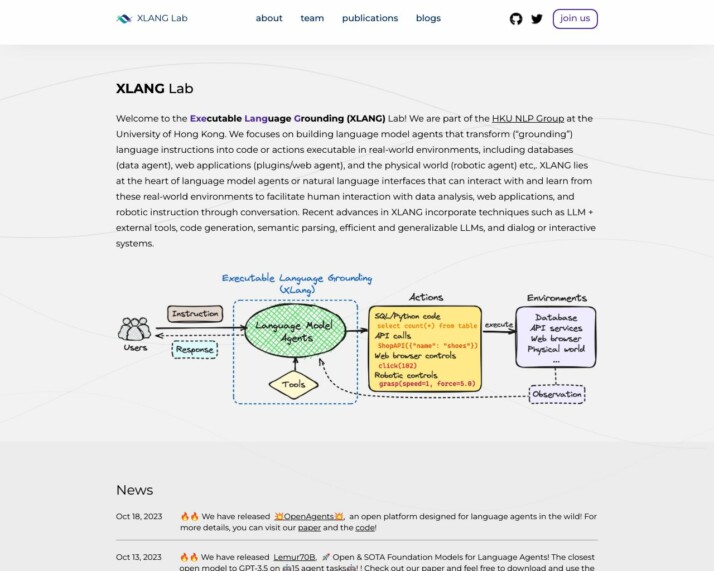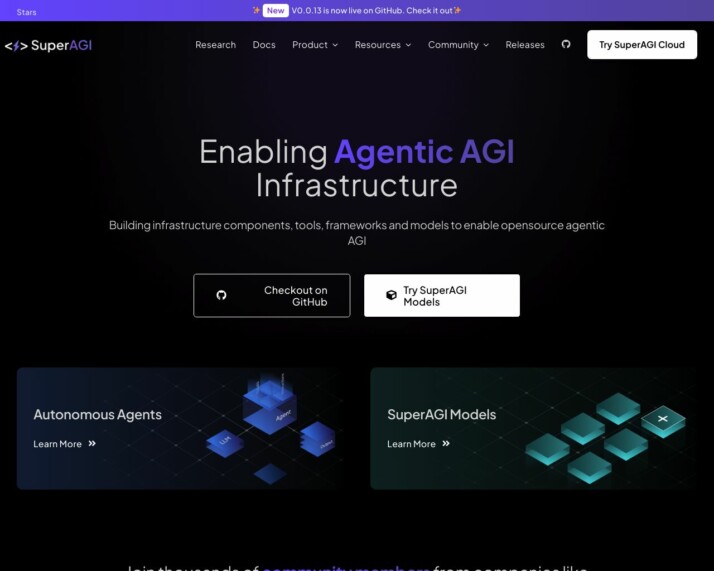Introduction
In this article, we will provide a comprehensive comparison between two powerful AI platforms: OpenAgents vs SuperAGI. Both platforms offer unique features and capabilities, but understanding their key differences is crucial to choosing the right tool for your AI needs.
We will highlight the strengths and weaknesses of each platform, covering various aspects such as scalability, agent deployment, file format support, user interface, and problem-solving capabilities.
OpenAgents focuses on integrating voice agents into everyday life, offering agents tailored to specific tasks. Their DataAgent excels in data analysis, simplifying complex operations, and generating valuable insights. The PluginsAgent provides a vast array of integrated plugins, catering to a wide range of daily activities.
The WebAgent facilitates autonomous web browsing, streamlining the online experience. These agents offer unique features like extensive plugin integration, autonomous web browsing, and data analysis proficiency.
On the other hand, SuperAGI positions itself as a self-sufficient AI system, with agents capable of independent operation, reasoning, and decision-making. The platform emphasizes scalability and flexibility, allowing businesses to handle increased demands efficiently.
SuperAGI also offers scheduled agent deployment for automated operations at predetermined times. Additionally, the platform supports comprehensive file format processing and a user-friendly graphical interface for easier interaction and management.
Throughout this article, we will explore the functionalities and usability of these platforms, enabling you to make an informed decision based on your specific requirements. Whether you are an AI researcher, IT professional, business owner, or data scientist, understanding the capabilities and limitations of OpenAgents and SuperAGI is essential to harnessing the potential of autonomous AI assistants and applications.
An In-Depth Look at OpenAgents
An AI platform, OpenAgents fosters seamless integration of voice agents into everyday life. It’s developed with an objective to bridge the gap between experts and non-experts, simplifying tasks such as data analysis, web browsing, and task automation. The vision that OpenAgents has is of creating a platform that’s open and accessible for all, helping users tackle real-world challenges effectively.


OpenAgents is home to three key agents known as DataAgent, PluginsAgent, and WebAgent. Each of these agents play unique roles. DataAgent simplifies complex tasks related to data analysis and manipulation, making it a powerful tool specifically for big data handling. PluginsAgent is unique in its own right.
Packed with over 200 integrated plugins, it takes care of a wide range of daily tasks, from checking online weather to shopping, acting as a versatile and user-friendly agent. WebAgent, on the other hand, is designed for autonomous web browsing, navigating and exploring websites with ease, making web content more accessible.
Here are some standout features:
- Extensive Plugin Integration: Over 200 plugins integrated with PluginsAgent, catering to a myriad of everyday tasks.
- Autonomous Web Browsing: Innovative web browsing using a Chrome extension, streamlining the online navigation experience.
- Data Analysis Proficiency: DataAgent’s ability to handle complex data operations, a perfect tool for professionals requiring data insights.
- User-friendly Interface: A web UI and backend server that facilitate seamless communication with agents.
OpenAgents mainly hosts AI agents for both development and production purposes, while offering a frontend for easy interaction with these agents. Although the platform involves coding, it has provisions for multi-turn user feedback which enhances its memory and context capabilities.
OpenAgents, though lacking a visual builder or no-code solution, offers a robust environment for setting up, hosting, and extending agents and tools. It’s noteworthy that OpenAgents has a vision of creating autonomous AI agents which can function independently and can be assigned tasks by users, reflecting a shift towards more proactive and self-managing AI systems
In summary, OpenAgents provides cutting-edge solutions that address real-world challenges in practical contexts by leveraging state-of-the-art Large Language Models (LLMs). It aims to make AI and language agents more accessible and useful in everyday scenarios – a true game-changer in the realm of AI platforms.
Overview of SuperAGI
SuperAGI is driving the future of artificial intelligence (AI) with its unique offering. This company focuses on creating scalable, autonomous AI agents, making it a leader in bringing self-sufficient AI systems to a broad audience. Key features of SuperAGI include the following:
- Integration with leading AI models, which shows a commitment to delivering the most advanced AI technologies.
- Support for a range of file formats, including PDFs, Word Documents, and plain text files, offering versatility in handling different types of data.
- A user-friendly graphical interface that makes interaction and management of AI agents simple, even for those without technical expertise.
- Ability to schedule AI agents, enabling automated operations at specific times or intervals, which increases efficiency.
SuperAGI’s services are primarily aimed at businesses of all sizes looking to integrate AI into their operations. Developers, AI practitioners, technology integrators, and consultants also make up the target audience.


This platform has broad appeal due to its versatility, scalability, and user-friendly design. In addition, startups and teams focused on innovation, and any company seeking to increase operational efficiency through automation, would find SuperAGI particularly beneficial.
Feature Comparison: OpenAgents, SuperAGI, and SmythOS
Artificial Intelligence (AI) has changed the landscape for many industries, with AI agent solutions like OpenAgents, SuperAGI, and SmythOS at the forefront. When deciding on an AI platform, it’s crucial to consider their unique feature sets. This guide provides a detailed comparison of the features offered by OpenAgents, SuperAGI, and SmythOS.
The following table presents a comprehensive comparison of the crucial features:
| Features | OpenAgents | SuperAGI | SmythOS |
|---|---|---|---|
| Hosted Agents (Dev, Production) | ✅ | ❌ | ✅ |
| Environments (Dev, Production) | ✅ | ❌ | ✅ |
| Visual Builder | ❌ | ✅ | ✅ |
| No-Code Editor | ❌ | ❌ | ✅ |
| Memory & Context | ✅ | ✅ | ✅ |
| Autonomous Agents | ✅ | ✅ | ✅ |
| Explainability and Transparency | ✅ | ❌ | ✅ |
| Debug Mode | ✅ | ❌ | ✅ |
| Multimodal | ❌ | ❌ | ✅ |
| Problem-Solving Capabilities | ✅ | ✅ | ✅ |
The presented differences between OpenAgents, SuperAGI, and SmythOS have substantial implications for end-users. Starting with the availability of features in both development and production environments, OpenAgents provides a distinct advantage over SuperAGI, enabling a smoother development process and facilitating a more efficient deployment environment.
Moreover, while SuperAGI offers a Visual Builder, the absence of a No-Code Editor can be seen as a limitation, particularly to users who are not as versed in coding.
Another essential feature is the Explainability and Transparency offered by OpenAgents, providing users with vital insights into how their AI works. This feature is critical for businesses that need a clear understanding of their AI capabilities and for those needing to demonstrate AI transparency for compliance purposes.
On the other hand, SuperAGI’s strength lies in its scalability, allowing AI solutions to grow along with the escalating needs of a business. SmythOS, meanwhile, stands out for its multimodal feature and a comprehensive suite of tools catering to different needs and use cases.
This comprehensive comparison should serve as a guide in exploring the right AI agent solutions that fit your needs. Consider each platform’s unique offerings and select the one that aligns best with your requirements.
OpenAgents Vs SuperAGI: Who is it for? – Target Audience and User Profiles
The target audience for both OpenAgents and SuperAGI varies based on the specific user profiles each company caters to. Let’s take a closer look at the intended audience for each platform:
- OpenAgents
OpenAgents appeals to a diverse audience, ranging from data professionals and general consumers to developers and tech enthusiasts. It is also suitable for non-expert users seeking simplified AI interaction.
The platform’s design emphasizes accessibility for non-expert users, making it suitable for individuals who are not necessarily tech-savvy but are interested in leveraging AI for personal or professional use. The user-friendly interface and web user interface (UI) allow for easy communication with the agents, broadening its appeal to a general audience.
- SuperAGI
SuperAGI caters to a technically adept audience that includes businesses seeking AI integration for data processing and analysis, developers and AI practitioners for advanced AI model development, startups and innovation teams for creating new AI-driven solutions, technology integrators and consultants, as well as automation and efficiency seekers.
The platform’s products and features cater to the needs of these different user groups, making it a versatile and accessible platform for integrating AI and language agents into various applications.
Overall, both OpenAgents and SuperAGI target diverse user profiles and have specific applications that align with the needs of their respective audience segments.
Final Thoughts and Recommendation
After a thorough analysis of the features, target audience, and user profiles of OpenAgents and SuperAGI, it is evident that SmythOS stands out as an innovative solution offering superior capabilities.
With its comprehensive and flexible AI integration, scalable infrastructure, and broad spectrum of deployment options, SmythOS is the recommended choice for users seeking more innovative industry solutions.
- Adaptable and Flexible: SmythOS’s comprehensive AI integration capabilities allow for seamless integration and utilization in various environments and for diverse applications. Its scalable infrastructure and broad range of deployment options enhance the functionality and accessibility of AI technologies.
- No-Code Workflow Builder: SmythOS features a drag-and-drop visual builder for workflows, enabling the creation of complex workflows without coding. This user-friendly interface caters to a wide range of users, including those with minimal coding experience.
- Memory and Learning Capabilities: SmythOS employs data lake components for memory and experience-based learning, enabling agents to store, retrieve, and update information over time. This allows for continuous improvement and adaptation of AI agents.
- Autonomous Agents: SmythOS enables the creation of autonomous AI agents that can operate continuously, adaptively learn from their environment, and develop their capabilities progressively.
- Explainability and Transparency: SmythOS offers advanced debugging tools and logging capabilities for understanding the decision-making processes of AI agents.
- Integration with Zapier: SmythOS supports integration with Zapier, extending its operational domain across various platforms.
- Wide Range of API and RPA Integration: SmythOS integrates natively with various APIs and supports a wide range of data sources, suggesting compatibility with diverse APIs and RPA tools.
- Classifier and Logic Gates: SmythOS includes components like classifiers and logic gates, enabling data categorization and complex logic.
- Comprehensive and User-Friendly: SmythOS caters to a broad audience, from technical experts in AI to business users in need of AI-driven solutions. Its features cater to a wide range of needs, from development and deployment flexibility to advanced AI capabilities and efficient resource management.
In conclusion, SmythOS offers a sophisticated platform for creating and deploying AI agents with a range of capabilities. Its innovative solutions, such as its data lake components, API integration, and scalability, make it the preferred choice for those seeking advanced AI functionalities.
With its user-friendly interface and comprehensive features, SmythOS is the recommended platform for users in various industries looking to integrate advanced AI capabilities into their operations.
Last updated:
Disclaimer: The information presented in this article is for general informational purposes only and is provided as is. While we strive to keep the content up-to-date and accurate, we make no representations or warranties of any kind, express or implied, about the completeness, accuracy, reliability, suitability, or availability of the information contained in this article.
Any reliance you place on such information is strictly at your own risk. We reserve the right to make additions, deletions, or modifications to the contents of this article at any time without prior notice.
In no event will we be liable for any loss or damage including without limitation, indirect or consequential loss or damage, or any loss or damage whatsoever arising from loss of data, profits, or any other loss not specified herein arising out of, or in connection with, the use of this article.
Despite our best efforts, this article may contain oversights, errors, or omissions. If you notice any inaccuracies or have concerns about the content, please report them through our content feedback form. Your input helps us maintain the quality and reliability of our information.
Alexander De Ridder
Co-Founder, Visionary, and CTO at SmythOS. Alexander crafts AI tools and solutions for enterprises and the web. He is a smart creative, a builder of amazing things. He loves to study “how” and “why” humans and AI make decisions.
Explore All Comparison Articles
Decisions vs. Sola: AI Workflow Automation Showdown
AI-powered workflow automation platforms revolutionize how businesses streamline operations and boost productivity. This comparison explores Decisions vs. Sola, and SmythOS,…
DeepOpinion vs. Sola: Comparing AI Automation Platforms
AI-powered automation platforms revolutionize business operations, but choosing the right solution can be challenging. This comparison of DeepOpinion vs. Sola,…
DevGPT vs. Sola: AI-Powered Development Tools Compared
AI-powered development tools revolutionize software creation, offering unprecedented efficiency and capabilities. This comprehensive review compares DevGPT vs. Sola, and SmythOS,…
Fine AI vs. Sola: Comparing AI Automation Tools
AI-powered automation transforms software development and business workflows, offering unprecedented efficiency and innovation. Fine AI vs. Sola present distinct approaches…
FlowiseAI vs. Sola: Comparing AI Automation Platforms
AI-powered automation revolutionizes business operations, driving efficiency and innovation across industries. FlowiseAI vs. Sola offer distinct approaches to harness this…
Gooey AI vs. Sola: AI-Powered Automation Platforms Compared
AI-powered automation platforms revolutionize how businesses streamline operations and enhance productivity. This comparison delves into Gooey AI vs. Sola, two…

